#Vibrio
Text
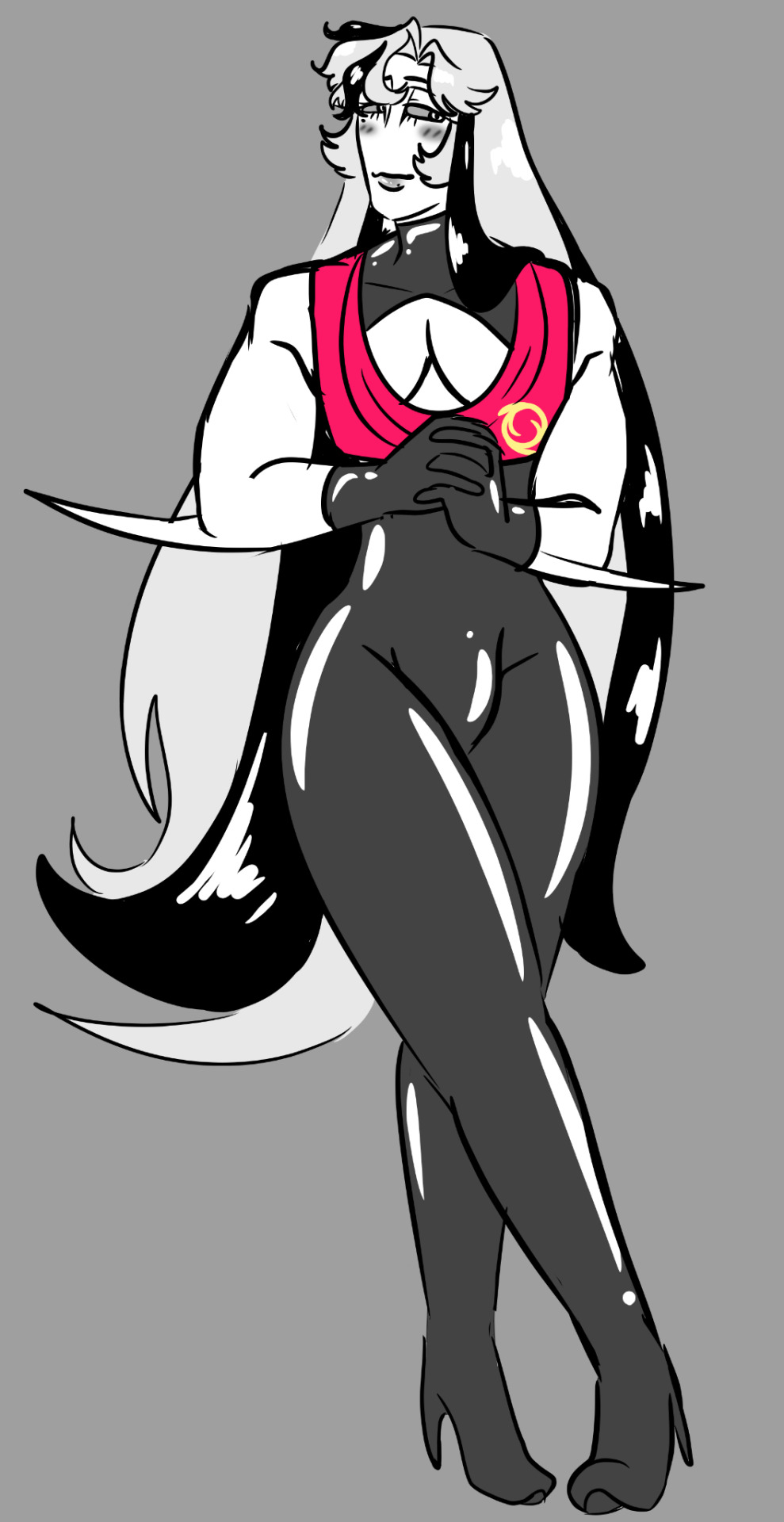
His name is Vibrio, he's a Clear Quartz, he's head mechanic for Towering Inferno's starship racing team, and I think he falls in love easy and fucks hard
I wanted to draw someone more masculine when I came up with him, but he's uuuuuh, not as masculine as I was aiming for, but still, I like his flavor of masculinity
12 notes
·
View notes
Text

Vibrant Vibrio.
11 notes
·
View notes
Text
US Woman Loses All Four Limbs After Eating Contaminated Fish
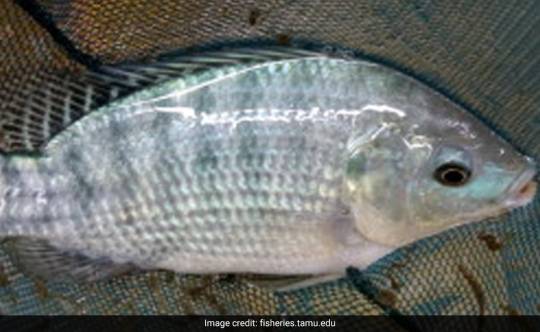

Laura Barajas got the infection from undercooked tilapia fish.A tragic incident has unfolded in California, where a woman has lost all four of her limbs. This devastating outcome is the result of her contracting a bacterial infection, reportedly stemming from the consumption of undercooked tilapia fish that had been contaminated with a lethal strain of bacteria, according to accounts from her friends.Laura Barajas, a 40-year-old mother, underwent the lifesaving surgery on Thursday after a months-long stay in the hospital, the New York Post reports."It's just been really heavy on all of us. It's terrible. This could've happened to any of us," Ms Barajas' friend Anna Messina told KRON.Messina said Barajas became sick after eating the fish that she had purchased at a local market in San Jose and made for herself at home."She almost lost her life. She was on a respirator," Ms Messina said."They put her into a medically induced coma. Her fingers were black, her feet were black, and her bottom lip was black. She had complete sepsis, and her kidneys were failing," she added.Ms Messina has stated that Barajas contracted Vibrio vulnificus, a potentially deadly bacterium commonly found in raw seafood and seawater. This underscores the critical importance of properly preparing and handling seafood to avoid such severe health risks."The ways you can get infected with this bacteria are, one, you can eat something that's contaminated with it the other way is by having a cut or tattoo exposed to water in which this bug lives," UCSF Infectious Disease Expert Dr. Natasha Spottiswoode told KRON.
Read the full article
0 notes
Video
A bacterial disease causing severe diarrhoea and dehydration, usually spread in water.
#Drugcarts#onlinepharmacy#pharmacy#microbiology#medicine#healthcare#doctor#cholera#health#rabies#yemen#bacteriology#tetanus#vibrio#vibriocholerae#epidemic#africa#measles#pneumonia#nigeria#ebola#typhoid#children#lowrider#oldies#chicana#polio#chola#science#microbes
0 notes
Text
Catch of the day: lots and lots of microbiology
Catch of the day: lots and lots of microbiology
Over the past few months, a large team of undergraduate, graduate, and postdoctoral researchers, and I, have been processing hundreds of samples from our scallop hatchery microbiome project. As 2022 winds down, so does the first phase of our lab work, and we are taking a well-deserved break over the holidays before we launch additional lab work, data analysis, and manuscript writing in 2023.
In…
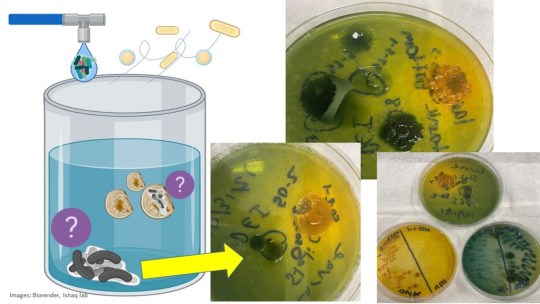
View On WordPress
0 notes
Text
Vibrio bacteria, named for their vibrating swimming motion, span approximately 150 known species. Most Vibrio live in brackish or salt water, either swimming free or living as pathogens or symbionts in fish, crustaceans, mollusks, and corals. Because Vibrio thrives at relatively high temperatures, outbreaks in marine animals are expected to become ever more frequent under global warming. For example, over the past few decades, Vibrio have been implicated in the 'bleaching' of subtropical and tropical corals around the world.
Now, researchers from Spain and Turkey have shown that Vibrio bacteria also play a role in outbreaks of mortality of an unrelated sessile marine organism, the dark stinging sponge (Sarcotragus foetidus). The results are published in Frontiers in Microbiology.
"Here we show that pathogenic Vibrio bacteria were abundant in diseased individuals of the dark stinging sponge, during a deadly outbreak first observed in late 2021 in the Aegean Sea," said Dr. Manuel Maldonado, a senior scientist at the Spanish National Research Council (CEAB-CSIC) and a co-author of the study.
Continue Reading.
98 notes
·
View notes
Note
So how do hawaiian bobtail squids select their bacterial partners?
I have a doodle from years ago just for this question!
So when bobtails first hatch, they don't have the bioluminescent bacteria they need to blend in with moonlight coming from above.





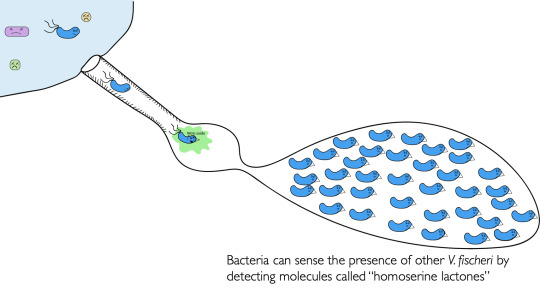
Making light is super energetically expensive, so they don't want to make light if they don't have to. They wait until as a group they can produce enough light to be useful for the squid.
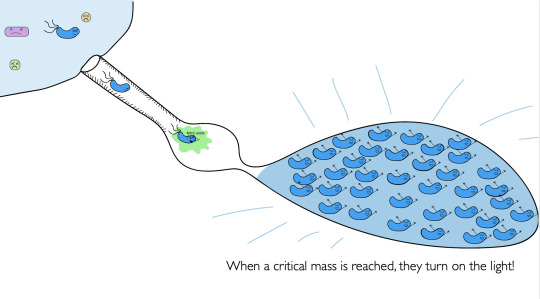
505 notes
·
View notes
Text
There are many mechanisms by which zoonotic pathogens can acquire the ability to spread directly between people, severing the cord that binds them to their reservoir animals. Vibrio cholerae did it by acquiring the ability to produce a toxin.
The toxin was the vibrio's pièce de résistance. Normally, the human digestive system sends food, gastric and pancreatic juice, bile, and various intestinal secretions to the intestines, where cells lining the gut extract nutrients and fluid, leaving behind a solid mass of excreta to expel. The vibrio's toxin altered the biochemistry of the human intestines such that the organ's normal function reversed. Instead of extracting fluids to nourish the body's tissues, the vibrio-colonized gut sucked water and electrolytes out of the body's tissues and flushed them away with the waste.
The toxin allowed the vibrio to accomplish two things essential to its success as a human pathogen. First, it helped the vibrio get rid of its competitors: the massive torrents of fluids sloughed off all the other bacteria in the gut, so that the vibrio (clinging to the gut in its tough micro-colonies) could colonize the organ undisturbed. Second, it assured the vibrio's passage from one victim to another. Even tiny drops of that excreta, on unwashed hands or contaminated food or water, couldcarry the vibrio to new victims. Now, so long as the vibrio could get into a single person and cause disease, it could spread to others, whether or not they exposed themselves to copepods or ingested the vibrio-rich waters of the Sundarbans.
The first pandemic caused by the new pathogens began in the Sundarbans town of Jessore in August 1817 after a heavy rainfall. Brackish water from the sea flooded the area, allowing salty copepod-rich waters to seep into people's farms and homes and wells. V. cholerae slipped into the locals' bodies and colonized their guts. Thanks to the toxin, Vibrio cholerae's basic reproductive number, according to modern mathematicians, ranged from 2 to 6. A single infected person could infect as many as half a dozen others. Within hours, cholera's first victims were being drained alive, each expelling more than fifteen quarts of milky-white liquid stool a day, filling the Sundarbans' streams and waste pits with excreta. It leaked into farmers' wells. Droplets clung to people's hands and clothes. And in each drop, vibrio bacteria swarmed, ready to infect a new host.
The Bengalis called the new disease ola, for “the purge”. It killed people faster than any other disease known to humankind. Ten thousand perished. Within a matter of months, the new plague held nearly two hundred thousand square miles of Bengal in its grip.
Cholera had made its debut.
— Pandemic: Tracking Contagions, from Cholera to Ebola and Beyond (Sonia Shah)
#sonia shah#pandemic: tracking contagions from cholera to ebola and beyond#science#virology#epidemiology#ecology#microbiology#biology#human biology#history#medicine#medical history#colonialism#1817-1824 cholera pandemic#india#bay of bengal#sundarbans#jessore#vibrio cholerae#cholera#water
4 notes
·
View notes
Text
okay my microbiology class is having me look up pathogenic bacteria and so many have ae somewhere in the scientific name. cholera should not be as gender as it is someone send help
#like how am i supposed to function when Vibrio cholerae is right there#and haemophilus influenzae#and streptococcus pneumoniae#and bartonella henselae#and neisseria gonorrhoeae#make it stop
3 notes
·
View notes
Text
That post reminded me how there are plenty of diseases that have such pretty names it makes me mad
0 notes
Text
"Vibrio parahaemolyticus" is very fun to say
1 note
·
View note
Text
Find the Standard Quality of TCBS Agar (TM 436) at TM Media
Thiosulfate Citrate Bile Salts Sucrose Agar, commonly known as TCBS Agar, is a specialized culture medium widely used in microbiology for the isolation and identification of Vibrio species, particularly Vibrio cholerae, a bacterium responsible for cholera. Developed to selectively cultivate and differentiate these bacteria, TCBS Agar contains key components such as thiosulfate, citrate, bile salts, sucrose, and agar.
The medium's selective properties are attributed to the presence of bile salts, which inhibit the growth of most Gram-positive bacteria, allowing for the preferential isolation of Gram-negative Vibrio species. Additionally, the inclusion of sucrose as a fermentable carbohydrate encourages the differentiation of Vibrio cholerae based on its ability to ferment sucrose.

0 notes
Text
TCBS Agar

TCBS Agar is a culture medium designed to selectively isolate Vibrio species, a group of bacteria that can cause a variety of foodborne and waterborne illnesses. It was developed by Kobayashi et al. in 1963 as a modification of Nakanishi's Medium.
TCBS Agar contains a variety of ingredients that make it selective for Vibrios. These include bile salts, which inhibit the growth of many other types of bacteria, and sucrose, which is fermented by most Vibrios. Vibrio cholerae, the most common cause of cholera, produces yellow colonies on TCBS Agar due to sucrose fermentation. Other Vibrio species, such as V. parahaemolyticus and V. vulnificus, do not ferment sucrose and produce blue-green colonies.
TCBS Agar is a highly sensitive and specific medium for the isolation of Vibrios. However, it is important to note that some other bacteria, such as Pseudomonas and Aeromonas, can also grow on TCBS Agar and produce blue-green colonies. Therefore, it is important to confirm the identity of any presumptive Vibrio isolates using additional tests.
#tcbs agar#tcbs agar manufacturer#dehydrated culture media#microbiology#food testing#food industries#clinical diagnostics#tcbs agar (vibrio selective agar)
0 notes
Text
"Health experts are advising beachgoers to stay away from sargassum if they encounter it on beaches. “Our lab work showed that these Vibrio are extremely aggressive and can seek out and stick to plastic within minutes,” Tracy Mincer, one of the lead authors of the study, told The Hill.
“We also found that there are attachment factors that microbes use to stick to plastics, and it is the same kind of mechanism that pathogens use.”
#flesh eating bacteria on sargassum#seaweed and plastic pollution#Protect The Oceans#Beneath The Surface Lies The Future#Plastic Pollution#Vibrio bacteria#Florida Atlantic University#Water Research#Rotting beached sargassum#Science Rules#Protect The Planet
0 notes